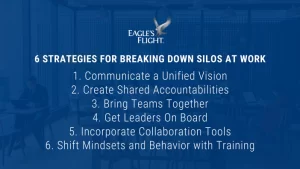The relentless pace of change in the corporate world today requires teams to collaborate and innovate. Therefore, company culture must overcome silos and support effective, cross-functional interaction between teams. When teams break out of their silos, the organization has a better chance for long-term success. In a survey of global operations managers, 61 percent cited cross-functional collaboration as being the key to helping the company reach strategic goals. Here are six strategies that can help break down silos and foster greater cross-functional collaboration across the entire organization:
Communicate a Unified Vision
Often, organizational silos form because individual or departmental goals have become such a priority that they become all-important, causing employees to lose sight of broader company goals and purpose. A unified vision that is broadly communicated among employees helps individuals to understand that individual and team goals are secondary to organizational vision.
For organizations that have grown accustomed to operating in silos, the vision will need to be communicated often and across different mediums so that it remains top of mind. When people see the bigger picture, they can begin to understand their unique place in the organization, as well as that of others. In time, a focus on self and team will expand to include other individuals and teams that are also part of the company vision.
Create Shared Accountabilities
Once a unifying vision has been established and communicated, it needs to translate into the everyday behaviors of teams and individuals to take hold. Teams can benefit from having shared goals that pull them together rather than divide them. For example, an organization might align the IT department’s goals with those of other departments to ensure more efficient use of internal IT systems. To further break down organizational silos, it can also be helpful to have two or more teams work together on a task force that ends with a joint presentation to senior management.
Bring Teams Together
Breaking down organizational silos and increasing cross-team collaboration doesn’t happen on its own, but will be more likely when individuals have opportunities to interact and work together. Joint meetings, focus groups, and chat sessions can provide employees with opportunities to get to know people from other teams, who does what, and how they can help each other to achieve company goals. Other activities that bring teams together include combining similar teams under co-heads, or co-locating teams that can benefit from being in close physical proximity, as in the case of companies that sit sales and marketing teams together. Organizing a corporate events can also promote collaboration, build trust, and encourage relationships between teams.
Get Leaders On Board
People on different teams will be unlikely to collaborate and will remain in silos unless they see leaders modeling collaborative behavior. Company leaders need to set the example to demonstrate that they expect cross-functional teamwork and information sharing from their employees. Leaders can support greater collaboration in the following ways:
- Talk about shared goals between teams
- Assign a team member or two to keep another team in the loop on a key project
- Regularly communicate and spend time with leaders of other teams
- Recognize and reward individuals who demonstrate collaboration with other teams
Incorporate Collaboration Tools
In the digital age, there is a range of workplace collaboration tools that can bring teams together in the cloud, making it easier to share ideas and information. Digital collaboration tools can be particularly helpful in unifying remote teams and individuals. Some examples include:
- Project management platforms with chat and virtual whiteboard capabilities
- Shared documents that allow multiple teams to access and collaborate
on presentations, proposals, and project plans - Data management tools that incorporate data from other platforms—for example, a CRM that integrates with company dashboards used by various teams
Shift Mindsets and Behavior with Training
A great way to help employees break free from silos is to train them to engage in behaviors that support more teamwork and collaboration. With the help of accountability, communication, and leadership training to name a few, employees can learn more about the dangers of silos, see the benefits of collaboration, and practice useful techniques for breaking down silos back on the job.
Organizational silos stand in the way of innovation and growth. They also limit the success of individuals, preventing them from realizing the positive benefits of teamwork and collaboration. By using strategies that encourage individuals to think of themselves as part of the broader organizational team, more cross-functional collaboration can become a reality.












